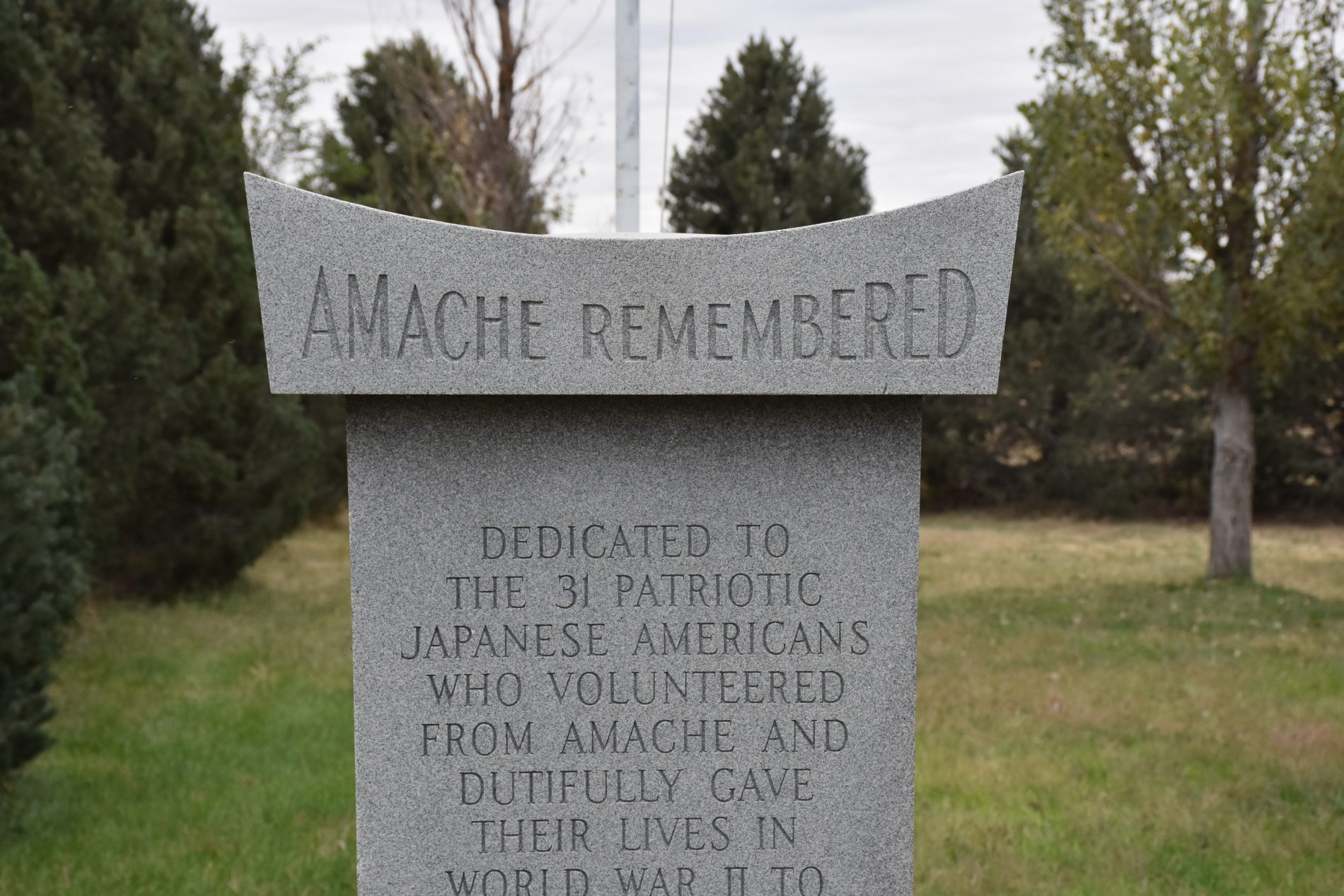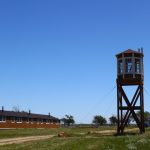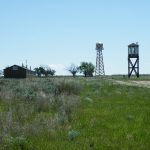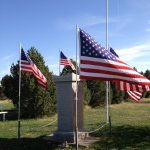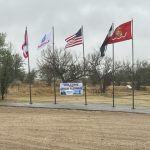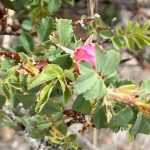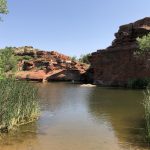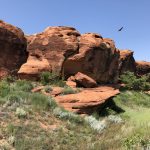Itinerary 1
Prowers County in eastern Colorado is full of rich, colorful, and sometimes complicated history. From prehistoric times, through the gold rush, both World Wars, the Dust Bowl, and more, you can take a deep dive into our country’s history as it played out on the great high prairies of Prowers County. From your base camp in Lamar, the opportunities for exploration are many, and you’re guaranteed to learn a thing or two!
Day 1 (southern loop)
Start your journey with a visit to the Colorado Welcome Center in the historic Lamar Railroad Depot to get maps and the lay of the land of southeastern Colorado. The friendly and knowledgeable staff and volunteers love to share their recommendations on everything from favorite restaurants to the best spots to cool off after a day of traveling.
Pick up a picnic lunch in Lamar for your next stop at Two Buttes Reservoir State Wildlife Area for incredible birding and wildlife viewing among the beautiful red rock formations. Don’t miss the Black Hole on the other side of the dam from the reservoir, where you’re likely to catch local kids swimming and jumping from the rocks.
(distance Lamar to Two Buttes Reservoir 36.4 miles)
Be sure to pack out your picnic trash as you make your way to Springfield, the county seat of neighboring Baca County, where you can visit sites of the Dust Bowl. Even though the Dust Bowl was decades ago in the 1930s, you can still see the scars from this devastating time in our country.
(distance Two Buttes Reservoir to Springfield 17.8 miles)
Make a point to drive through the Twin Buttes wind farm on your way back to Lamar. You’ll be amazed at the massive turbines and the dramatic shift from the devastation of the Dust Bowl to harnessing wind for clean energy. The people of Prowers County are nothing if not resilient, as you’ll start to realize more times than you can count.
(distance Springfield to wind farm 28.4 miles)
Back in Lamar, grab burgers, fries and a cinnamon Sprite at BJ’s Burgers & Fries drive-in.
(distance 58.5 miles from Vilas to Lamar)
A variety of lodging options await you in Lamar:
Choose from nationally branded and locally owned hotels complete with swimming pools and restaurants, or cozy up at any of our charming area bed and breakfasts, where you’ll be treated to vast local knowledge over coffee and delicious breakfast. If camping – or glamping – is more your style, don’t miss the Sundance High Plains RV Park & Cabins.
Visit the Great High Prairie website for more information on all the lodging and dining options available.
Day 2 (northern loop)
Day 2 takes you on the northern loop where you’ll continue your fascinating look into the area’s rich history.
Start the day at the Big Timbers Museum to get a broad representation of the history of southeastern Colorado and the Great High Prairie. Be sure to check out the large collection of World War I posters!
From here, you’ll make your way to Granada for the Amache Museum and Camp Amache, the newest addition to the National Park System. The Granada Relocation Center, also known as Amache, was home to over 10,000 incarcerated Japanese Americans between 1942 and 1945. Amache was built in the summer of 1942 and featured cramped army-style barracks, laundry areas and bathrooms, as well as a school, hospital, recreation center, post office, store, barber shop and other shared facilities. The camp was surrounded by barbed wire fencing and watchtowers manned by armed guards. You’ll see restored barracks, a memorial to the Japanese Americans who volunteered to fight for the United States in World War II and more. Granada High School students working for the Amache Preservation Society have installed kiosks and other interpretive signage to help explain the site.
(distance from Big Timbers Museum to Amache Museum 18.9 miles)
The museum is open five days a week during the summer months, and by appointment when school is back in session.
After your Amache tour, be sure to stop for lunch at Shorty’s Cafe in Granada. This Mexican-American restaurant has been serving the community since the 1950s!
From here, head north toward Eads and the site of the Sand Creek Massacre National Historic Site. “Profound, symbolic, spiritual, controversial, a site unlike any other in America.”
(distance from Amache to Sand Creek Massacre National Historic Site 35 miles)
While this era of U.S. history can be difficult to contemplate, it’s equally important to remember. As Secretary of the Interior Deb Haaland recently noted when Amache received its National Historic Site designation, “As a nation, we must face the wrongs of our past in order to build a more just and equitable future.”
Itinerary 2
America’s first international highway, the Santa Fe Trail connected Missouri with Santa Fe, New Mexico from 1821 to 1880. Traders, troops and travelers made their way across this 800+ mile route for business, war, and hope for a better life. Over 180 miles of the Mountain Route of the trail crossed southeast Colorado with many portions still visible today. This route across the Comanche National Grassland is often marked with stone markers. Trail sites to visit include Bent’s Old Fort, Bent’s New Fort, Boggsville.
Lamar and Prowers County are the perfect headquarters for a couple of days exploring history and the Great High Prairie. Head west on Day 1 to visit Bent’s New Fort and Bent’s Old Fort, looping back to Lamar via the Boggsville Historic Site. Day 2 takes you south to John Martin Reservoir and Prowers County’s own sunflower mill.
Day 1
Grab breakfast in Lamar before making your way to Bent’s New Fort. Learn the history of why William Bent left his trading post located near La Junta, Colorado in 1849 and chose this new location 40 miles to the east.
(distance Lamar to Bent’s New Fort 11.5 miles)
The next stop along the trail is Bent’s Old Fort, “The Castle of the Plains.” Bent’s Old Fort National Historic Site is a reconstructed fur trading post from the 1840s, where traders, trappers, travelers and tribes (Cheyenne and Arapaho) following the Santa Fe Trail came together for peaceful trade. On-site interpreters recreate the past with tours and demonstrations.
(distance Bent’s New Fort to Bent’s Old Fort 40.8 miles)
Lunch is delicious at Mexico City Cafe in La Junta before making your way to Boggsville.
The Boggsville Historic Site is included on the National Register of Historic Places as an early Colorado agricultural and trade center. It is also a certified site on the Santa Fe National Historic Trail. Learn more about renowned and influential characters of southeast Colorado, such as Zebulon Pike, Thomas Boggs, Jacob Fowler and William Bent, of Bent’s Old and New Forts. You can also see where many of them are laid to rest at the Baca County / Las Animas Cemetery.
(distance Bent’s Old Fort to Boggsville 17 miles)
Back in Lamar in time for dinner at La Mission Villanueva, serving Mexican fare from family recipes for over 40 years.
Rest up for a big day tomorrow! Visit the Great High Prairie website for information on the many available lodging options.
Day 2
Stop in Lamar for picnic supplies before heading to John Martin Reservoir. Here you’ll find uncrowded boating, waterskiing, and a variety of wind-powered water sports. Anglers can catch their limit of walleye, bass, crappie, perch, catfish, and more. John Martin Reservoir is also widely known for its birdwatching with 400 species documented, including bald eagles.
(distance Lamar to John Martin Reservoir 19. 2 miles)
Back in Lamar for the afternoon, schedule a tour of Colorado Mills, an innovative, environmentally-friendly, zero-waste company that connects farmers and customers with sunflower products. Be sure to take home a sample of their delicious, heart-healthy, sunflower oil.
Optional afternoon trip:
Comanche National Grasslands for hiking, bird watching, dinosaur tracks, and more.
(distance Lamar to Comanche National Grasslands 87.1 miles)
Itinerary 3
Denver has so many ties to Amache, you can start your history tour before you even leave the city! While the enhancements from Amache’s recent National Historic Site designation won’t be evident for a few years, the site still offers a meaningful visit, thanks primarily to the efforts of the Amache Preservation Society and local Granada High School teachers and students.
Start at the History Colorado Center where you can tour a reconstructed barracks from Amache and learn about life in the internment camps. Read the proclamations establishing the relocation centers and calling the interned men to fight for the United States in World War II.
For an uplifting story about strength, resilience and perseverance, visit the Denver Botanic Gardens to see rose bushes cultivated from rose bushes growing at Amache. It is believed the rose bushes at Amache were planted by Japanese Americans from Los Angeles interned at the camp. Cuttings from the bushes were sent to the Denver Botanic Gardens to see if they would grow and bloom. They will eventually be planted in the steppe garden. Cuttings from these rose bushes were also sent to Amache survivor 82-year-old Carlene Tanagoshi Tinker, who was 3 years old when she arrived at Camp Amache with her mother and father. The family was incarcerated there for about three years. Tinker now lives in Fresno, California and is tending to the roses as a symbol of survivorship.
After 80 years, the rose bushes at Amache flowered for the first time in May 2022, just in time to commemorate the camp’s designation as a National Historic Site and in honor of the annual pilgrimage to the site by descendents of internees.
Now you’re armed with insider knowledge to begin your journey to Amache and Prowers County. Heading south from Denver, you can stop at the Sand Creek Massacre site along the way. Once in Lamar, pick up lunch at a number of delicious restaurants, including Hickory House, La Lupita’s, Las Brisas or Lucy’s Tacos 2. Visit the Great High Prairie website for the full list of restaurants and accommodations in Prowers County.
Be sure to schedule a tour of the Amache Museum before heading to the site of the internment camp. Plan your visit here.
(distance from Denver Botanic Gardens to Lamar 206.3 miles)


